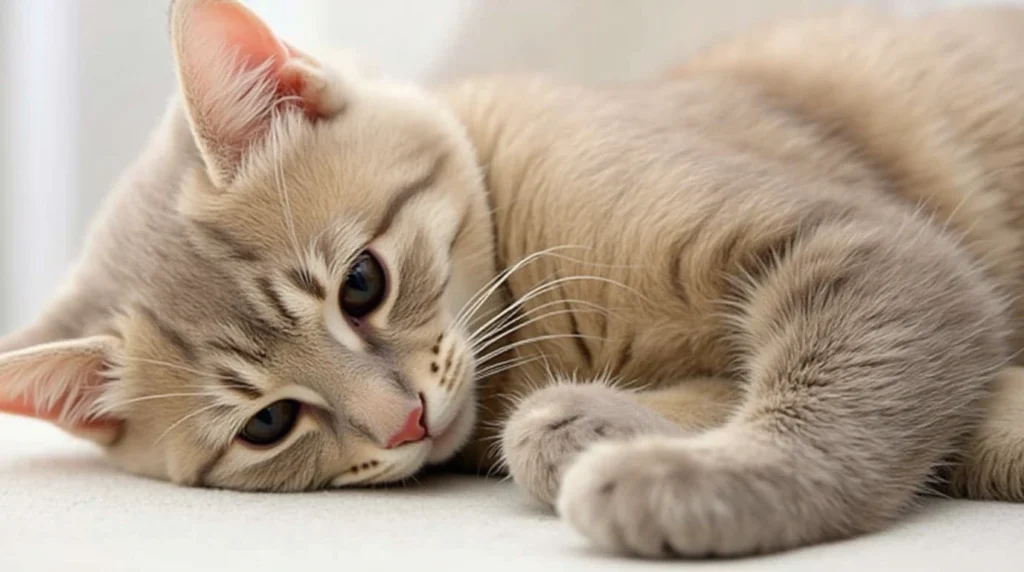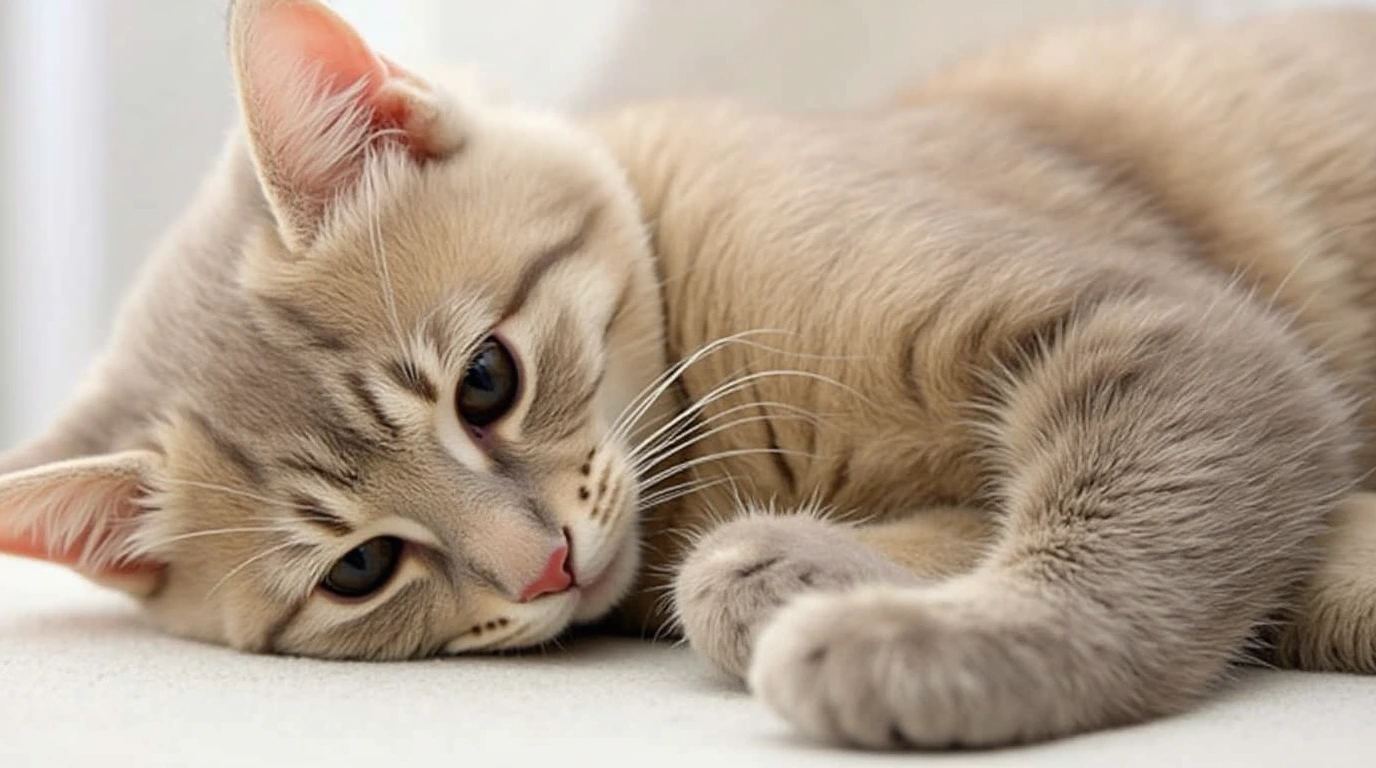Ever had that moment when your sweet little kitten suddenly starts howling at the window, pacing, spraying your favorite couch cushion — and you’re left thinking, “Wait… already?”
If you’ve asked yourself “When do male cats become sexually active?”, you’re not alone — and you’re not crazy. Puberty in cats can creep up unexpectedly fast, leaving many owners blindsided by a flurry of new behaviors that seem to pop up overnight. One minute they’re chasing feathers; the next, they’re chasing pheromones.
This guide is here to help you understand what’s really happening under the hood of that sudden shift. We’ll cover the typical age range for sexual maturity in male cats, how to spot the signs (some sneakier than others), and how to handle the behavioral curveballs that often come with this transition. We’ll also break down why timing matters when it comes to neutering — and how breed and environment can play a surprising role in your cat’s development timeline.
So, if you’re feeling caught off guard or just planning ahead — take a breath. You’re in the right place. Let’s decode the science and behavior of your cat’s sexual maturity, one meow at a time.

Table of Contents
Understanding Feline Puberty
Puberty in male cats doesn’t come with a warning bell — but if it did, it would probably start ringing somewhere between 4 to 6 months of age. That’s the general window when most male kittens begin transitioning from playful fluffballs into hormonally charged adolescents. But here’s the twist: not all cats hit puberty on schedule.
So, when do male cats become sexually active? While 5 months is the average starting point, some males — especially early-developing breeds like the Siamese — may begin showing signs as early as 4 months. Others, particularly larger or slower-maturing breeds like Maine Coons, might hold off until 8 or even 10 months.
What Triggers Puberty in Male Cats?
It’s not just age — several environmental and biological cues influence when your cat becomes sexually mature:
- Breed Type: As mentioned, Oriental breeds tend to mature faster than long-haired, heavy-bodied breeds.
- Daylight Exposure: Cats are seasonally influenced breeders, meaning increased daylight can stimulate hormone production. Indoor cats exposed to artificial light may mature faster than their outdoor counterparts.
- Nutrition and Health: Malnutrition or illness can delay sexual maturity, while a nutrient-rich diet supports normal hormonal development.
- Social Environment: Believe it or not, the presence of other sexually mature cats can trigger earlier puberty — it’s a social domino effect.
Why This Matters
Recognizing that the timeline isn’t fixed helps you stay one step ahead. Waiting too long to neuter may lead to entrenched behaviors (spraying, aggression), while early intervention can prevent them altogether. Knowing your cat’s breed, health, and environment can help predict when those hormones will kick in — and when to act.
FAQ: Can a male kitten impregnate a female at 5 months?
Yes, absolutely. If a male kitten has reached puberty — even as early as 4.5 to 5 months — he is capable of impregnating a female in heat. This is why many vets recommend neutering by 4 to 5 months to avoid accidental litters and prevent unwanted behaviors before they start.
Physical Indicators of Sexual Maturity
The moment your male cat starts strutting around like he owns the place — tail twitching, pupils dilated, suddenly obsessed with windows and doorways — that’s not just confidence. It’s biology doing its thing.
So, how do you know when a male cat becomes sexually active? The most telling signs aren’t always loud or dramatic at first — but they’re there, layered in both physiology and smell.
1. Testicle Development
This one’s straightforward: you’ll notice visible testicles descending in the scrotal sac — usually between 4 and 6 months. If your kitten had a sleek, flat rear end one week and suddenly seems… rounder down there, puberty is likely underway.
Some cats may have undescended testicles (cryptorchidism), which requires a vet check. But in most cases, they’ll be unmistakably present.
2. Stronger Urine Odor
This is the “nose knows” phase. As testosterone rises, urine becomes sharper, more pungent, and unmistakably territorial. Even litter-trained cats might start leaving scent markers around furniture, doorframes, or your favorite shoes. It’s not spite — it’s a chemical billboard that says, “I’m here. This is mine.”
3. Muscular Definition and Growth Spurt
Alongside hormonal changes, male cats often experience a noticeable increase in muscle mass and physical boldness. You might see broader shoulders, a thicker neck, or an overall shift in body posture — a sort of feline adolescence swagger.
4. Heightened Scent Gland Activity
Look out for increased rubbing of the cheeks and chin against objects. Male cats have scent glands in their faces, and once puberty kicks in, they double down on leaving their mark.
H3 – FAQ: Is it normal for a male kitten to spray before 6 months?
Yes — and it happens more than you’d think. While most male cats begin spraying after 5–6 months, some precocious kittens may start as early as 4 months. Spraying is driven by hormonal surges and territory instincts, so early neutering is key if you want to head it off.
Behavioral Changes in Sexually Mature Males
If you’ve ever looked at your once-snuggly kitten and wondered, “Why is he suddenly acting like a wild roommate with no boundaries?” — you’ve probably just met feline puberty.
Once male cats become sexually active, their behavior can shift — sometimes drastically — and often with zero regard for your sanity. These changes aren’t random mischief; they’re hardwired survival traits, activated by testosterone and an ancient instinct to mate, defend territory, and attract females.
1. Spraying and Marking
This is the headline act. Male cats mark territory using urine, and once puberty hits, this behavior ramps up. Even neutered males may spray occasionally, but unneutered adolescents often do it obsessively. Corners of rooms, furniture legs, and even your bedspread can become fair game.
It’s not about being dirty — it’s about declaring dominance and availability. To your cat, it’s Tinder via scent.
2. Vocalization and Yowling
You might notice a sudden surge in loud, throaty cries — especially at night. This “calling” behavior is meant to attract mates, and it can sound downright haunted. Many owners mistake it for pain or illness at first, but it’s just hormone-fueled serenading.
3. Roaming and Escape Attempts
Sexually mature males become little Houdinis. Roaming becomes a compulsion, especially if there are intact females nearby (even if “nearby” means three houses down). Open windows, loose screens, or slightly ajar doors become escape routes.
4. Increased Aggression and Dominance
Your cat may start displaying more assertive or aggressive behavior — toward other pets, strangers, or even you. This isn’t necessarily a sign of a bad temperament; it’s a testosterone-fueled effort to establish hierarchy. Swatting, staring, blocking pathways — all of it says, “I’m the boss now.”

FAQ: Will neutering stop these behaviors completely?
Mostly, yes — but timing matters. Neutering before these behaviors become habitual (around 4–6 months) gives you the best chance of avoiding or reversing them. If your cat has been spraying or roaming for months, some behaviors may persist post-neuter — though usually less intensely.
Breed-Specific Maturity Timelines
Not all male cats grow up at the same pace — and in the feline world, breed makes a big difference. If you’re scratching your head wondering why your Siamese kitten is already acting like Don Juan at four months while your Maine Coon seems stuck in toddler mode at seven, it’s not just personality. Breed-specific biology plays a big role in sexual development.
Early-Maturing Breeds
Certain cat breeds tend to reach sexual maturity on the early side — sometimes before five months. Owners of these cats need to be especially vigilant if they want to avoid unexpected behaviors (or litters). These include:
- Siamese & Oriental Shorthairs: Known for vocal, active personalities — and early hormone surges. These breeds can start exhibiting mating behaviors as early as 4 months.
- Bengals: Energetic and bold, Bengals may also mature quickly, sometimes around 5 months.
- Sphynx: Hairless but hormonally ahead of schedule — they tend to mature faster than many long-haired breeds.
Late-Maturing Breeds
Bigger-bodied cats often take their time reaching both physical and sexual maturity. With these breeds, you may not see full behavioral or physical signs of puberty until 8–10 months:
- Maine Coon: These gentle giants are slow growers across the board — full maturity (including sexual) may not occur until 9 months or beyond.
- Norwegian Forest Cat: With their sturdy build and thick coats, they’re typically late bloomers.
- Ragdoll: Known for their laid-back demeanor, Ragdolls may not act sexually mature until well after 6 months.
Why It Matters for Timing Neutering / When do male cats become sexually active
Understanding your cat’s breed timeline helps tailor the timing of neutering. While a blanket recommendation exists to neuter by 5 months, some cats may benefit from slight flexibility based on maturity speed — especially if they’re not showing behavioral changes yet.
But be warned: waiting too long can mean behaviors like spraying or roaming become ingrained. When in doubt, consult your vet — and remember, once puberty begins, things can accelerate quickly.
H3 – FAQ: Should I wait longer to neuter a late-maturing breed?
Not necessarily. Unless your vet recommends otherwise for health reasons, neutering before 5–6 months is still ideal — even for late bloomers. You’re preventing behaviors before they begin, not reacting to them after the fact.
Implications of Early vs. Delayed Neutering / When do male cats become sexually active
Neutering is one of those decisions you make with the hope that you’ll avoid bigger issues down the line. But then the questions creep in: What if I do it too early? Too late? Will it change who my cat is? You’re not alone — and yes, timing does matter.
When male cats become sexually active, you’re racing against a clock you don’t always see ticking. That’s why vets often advise neutering around 4 to 5 months — before hormones hit their stride. But it’s not just about fertility. It’s about what testosterone does to behavior, body, and long-term well-being.
Why Early Neutering Makes a Difference / When do male cats become sexually active
Neutering before puberty offers a kind of behavioral “reset button.” Without the testosterone surge:
- Spraying and marking are less likely to start.
- Roaming tendencies can be avoided altogether.
- Aggressive or dominant behaviors may never develop.
Health-wise, early neutering has been linked to:
- Reduced risk of testicular cancer (which becomes moot once testicles are removed).
- Lower rates of certain prostate issues later in life.
- A better chance at cohabiting peacefully with other pets.
Contrary to some myths, early neutering does not stunt growth — in fact, it can slightly delay the closing of growth plates, making neutered males a bit taller, but not in a problematic way.
Risks of Delayed Neutering / When do male cats become sexually active
Waiting too long can invite behaviors that don’t always disappear after surgery:
- Territorial spraying may persist out of habit.
- Roaming and escape attempts can become ingrained.
- Mounting behavior may continue even post-snip, especially if reinforced during peak hormone times.
In terms of physical health, the longer testicles are present, the higher the exposure to hormonal risks — though serious conditions like cancer are rare in young cats.
Finding the Right Window / When do male cats become sexually active
If your male cat is healthy and growing well, the 4–5 month range is typically a safe and effective window. But for late-maturing breeds or cats with health considerations, your vet might suggest slight delays — and that’s okay, as long as you’re monitoring signs of sexual maturity closely.
FAQ: Will my cat’s personality change after neutering?
Not dramatically — but expect subtle shifts. Most male cats maintain their core personality post-neuter. What often fades are the hormone-driven behaviors: spraying, yowling, roaming. Many owners find their cats become slightly calmer and more affectionate — but still very much themselves.
Managing Behavioral Issues Related to Sexual Maturity
Let’s be honest: dealing with a sexually maturing male cat can feel like living with a rebellious teenager who never sleeps and has zero concept of personal space. One day he’s kneading your lap, the next he’s trying to break out of a second-floor window to chase a phantom date.
If your cat is already showing signs of sexual maturity — spraying, yowling, chasing shadows like they’re prey — don’t panic. You’re not a bad pet parent. This is biology. But biology can be managed.
1. Neutering as a Behavioral Reset / When do male cats become sexually active
If your cat hasn’t been neutered yet, that’s your most powerful first move. Neutering halts the testosterone production driving most of these behaviors — and while it doesn’t undo habits instantly, it often leads to a gradual tapering of the chaos.
- Spraying may stop within weeks (sometimes days).
- Roaming urgency typically fades once mating hormones decline.
- Aggressive or restless behaviors soften as testosterone levels drop.
2. Create a Hormone-Resistant Environment / When do male cats become sexually active
While waiting for surgery or recovery, manage your cat’s environment like you would baby-proof a house:
- Secure all exits: Even screens can’t be trusted during a hormonal high.
- Use feline pheromone diffusers like Feliway to reduce anxiety and calm marking urges.
- Clean sprayed areas thoroughly with enzymatic cleaners. Cats will return to their scent marks if any trace remains.
3. Structured Stimulation / When do male cats become sexually active
A sexually maturing male is often mentally overstimulated but physically under-engaged. Combat this with:
- Regular interactive play (feather toys, laser pointers, puzzles).
- Food-dispensing toys to burn off frustration and redirect focus.
- Vertical space (cat trees, shelves) to fulfill territorial instincts in a safe way.
4. Vet Support & Behaviorists / When do male cats become sexually active
If behaviors continue post-neutering or escalate beyond management, consult your vet. Some cats benefit from short-term anxiety meds or behaviorist interventions — especially if aggression or compulsive spraying lingers.

FAQ: My cat is still spraying after neutering. Will it ever stop? When do male cats become sexually active
Possibly — but it takes time. If spraying began before neutering, the habit may stick for a while. You’re dealing with both a hormonal trigger and a learned behavior. Be patient, consistent with cleaning, and consider pheromone support or vet-guided behavioral training if needed.
Frequently Asked Questions (FAQs)
At what age should I neuter my male cat? When do male cats become sexually active
Most vets recommend neutering around 4 to 5 months old — before sexual maturity sets in. Early neutering helps prevent behaviors like spraying, roaming, and aggression before they start. If you’re unsure, ask your vet based on your cat’s breed and health.
Is it too late to neuter my male cat at 8 months? When do male cats become sexually active
Not at all. While earlier is ideal, it’s never “too late” to neuter from a health standpoint. Just know that if certain behaviors (like spraying or yowling) have already started, they may take longer to fade — or in rare cases, stick around out of habit.
Can indoor male cats still become sexually active? When do male cats become sexually active
Absolutely. Indoor status doesn’t affect hormones — it just reduces the risk of accidental mating. Male cats raised indoors will still go through puberty, develop mating urges, and display the same behaviors as outdoor cats unless neutered.
will neutering make my cat fat and lazy? When do male cats become sexually active
It’s a myth — or at least a half-truth. While neutered cats may have a slightly reduced metabolism, weight gain is about food intake and exercise. Feed appropriate portions, provide regular play, and your cat will stay fit, not flabby.
Can a neutered male cat still show mating behaviors? When do male cats become sexually active
Sometimes, yes. Especially if neutered after puberty, some cats retain residual behaviors like mounting or scent rubbing. These usually decrease over time, but a few quirks may remain — more out of muscle memory than motivation.
If you’ve made it this far, you’re probably deep in the weeds of cat puberty — or standing on the edge of it, wondering what’s coming. Either way, you’re not just reacting. You’re preparing, learning, trying to be the best guardian your cat could ask for. And that matters.
Now you know: male cats can become sexually active as early as 4 months, and when they do, it’s not subtle. The yowling, the spraying, the escape attempts — none of it means your cat has turned bad. It just means he’s growing up, fast.
The good news? You’ve got options. Whether you’re still on the fence about neutering or dealing with a cat who’s already in full hormonal swing, there’s always a path forward. With the right timing, environment, and a bit of patience, those chaotic behaviors can be managed — and often reversed.
Because at the heart of it, your cat isn’t trying to drive you mad. He’s just following biology’s lead. And you? You’re learning how to guide him through it.
That’s what makes you the grown-up in the room.

